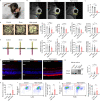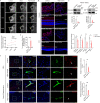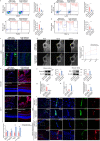CCL2-mediated inflammatory pathogenesis underlies high myopia-related anxiety
- PMID: 37699875
- PMCID: PMC10497683
- DOI: 10.1038/s41421-023-00588-2
CCL2-mediated inflammatory pathogenesis underlies high myopia-related anxiety
Abstract
High myopia is a leading cause of blindness worldwide. It may lead to emotional defects that rely closely on the link between visual sensation and the central nervous system. However, the extent of the defects and its underlying mechanism remain unknown. Here, we report that highly myopic patients exhibit greater anxiety, accompanied by higher CC chemokine ligand 2 (CCL2) and monocyte levels in the blood. Similar findings are found in the mouse model of high myopia. Mechanistic evaluations using GFP-positive bone marrow chimeric mice, parabiotic mouse model, enhanced magnetic resonance imaging, etc., show that highly myopic visual stimulation increases CCL2 expression in eyes, aggravates monocyte/macrophage infiltration into eyes and brains, and disrupts blood-ocular barrier and blood-brain barrier of mice. Conversely, Ccl2-deficient highly myopic mice exhibit attenuated ocular and brain infiltration of monocytes/macrophages, reduced disruption of the blood-ocular barrier and blood-brain barrier, and less anxiety. Substantial alleviation of high myopia-related anxiety can also be achieved with the administration of CCL2-neutralizing antibodies. Our results establish the association between high myopia and anxiety, and implicate the CCL2-mediated inflammatory pathogenesis as an underlying mechanism.
© 2023. Center for Excellence in Molecular Cell Science, CAS.
Conflict of interest statement
The authors declare no competing interests.
Figures







References
-
- Ruiz-Medrano J, et al. Myopic maculopathy: current status and proposal for a new classification and grading system (ATN) Prog. Retin. Eye Res. 2019;69:80–115. - PubMed
-
- Hayashi K, et al. Long-term pattern of progression of myopic maculopathy: a natural history study. Ophthalmology. 2010;117:1595–1611. - PubMed
-
- Ikuno Y. Overview of the complications of high myopia. Retina. 2017;37:2347–2351. - PubMed
-
- Yokoi T, et al. Predictive factors for comorbid psychiatric disorders and their impact on vision-related quality of life in patients with high myopia. Int. Ophthalmol. 2014;34:171–183. - PubMed
Grants and funding
LinkOut - more resources
Full Text Sources

